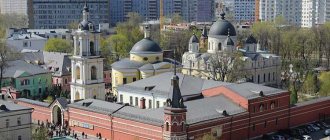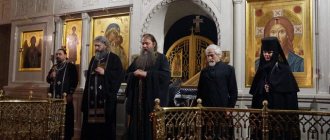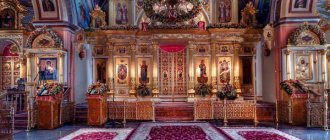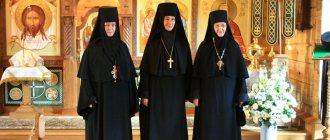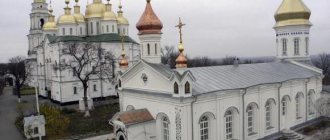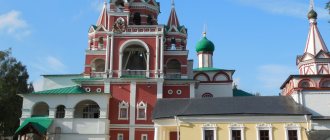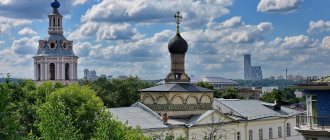Story
The date of foundation of the Intercession Khotkov Monastery is unknown, but the first record about it dates back to 1308. At first, the monastery was for men and women. In the 30s of the XIV century. The inhabitants of the monastery were not only the parents of the Venerable Abbot Sergius of Radonezh, but also his brother Stefan, who later went into the desert.
The monastery was very poor for more than two centuries, until in 1506 it received the Grand Ducal Ruga, a salary from the state treasury in the form of food. At the beginning of the 16th century, only 17 monks and nuns lived in the Intercession Monastery in Khotkovo. By the middle of the century, the monastery became completely female and came under the control of the Trinity-Sergius Lavra. The Church of the Intercession in those days was wooden. Nikolskaya was built near it in 1580.
During the Time of Troubles, the Trinity-Sergius Lavra was besieged. The Khotkovo monastery was destroyed and was restored with funds from the Sergius Monastery in the 1620s. Soon, at the expense of the patriarchal boyar Vasily Yanov, the construction of the stone Church of the Intercession in Khotkov began. Completed in 1648, this building was the first and for a long time the only stone building of the monastery. At this time, about 40 nuns and about 70 laywomen preparing for monastic vows constantly lived in the monastery.
Throughout the 18th century, construction was actively underway at the Intercession Monastery in Khotkovo. In 1745, a holy gate was built facing the Trinity Monastery, “the first in Russia.” Later, a fence with turrets and a gate church with an altar in the name of the Nativity of John the Baptist were built.
In 1764, the Intercession Monastery was detached from the Trinity Monastery and gained independence. The time of prosperity has begun. In just 50 years, the number of nuns and other residents of the monastery reached 400. At the beginning of the 19th century, under Abbess Eupraxia, the construction of stone cells and other buildings began. In those days, the Intercession Khotkov Monastery had a special habitation: each nun lived in her own cell and ran a separate household. On the territory of the monastery there was a market where nuns and squirrels traded grown products with residents of surrounding villages. Also, the nuns of the monastery were famous for their magnificent handicrafts. They spun, lace-making, and embroidered with gold and pearls. Church vestments made by Khotkovo nuns can be seen in the exhibition of the Sergiev Posad Museum.
In the middle of the 19th century. it was decided to gradually move to a communal structure. After 30 years, all the nuns lived in the cells provided and at the expense of the monastery. Trade was also moved outside the monastery walls. Before the revolution, the Pokrovsky Monastery operated an icon-painting workshop, a school for boys and girls for 70 people, an almshouse and a hospital.
The Intercession Monastery was closed during Soviet times (in 1922). A warehouse and industrial artel were located here. During a fire in 1985, the frescoes of the temple were lost, and the temple itself was in a dilapidated state. The relics of Saints Cyril and Mary were buried during this period. In 1989, restoration work began, worship and monastic life resumed. Both cathedrals have now been restored. The monastery has a Sunday school, a boarding house for girls and theological courses.
Abbesses
- Petronida (c.1604)
- Euphemia (Korolvinskaya) (mentioned September 1641)
- Julia I (c. 1689)
- Feodosia (Kulichkina) (September 9, 1692 - ?)
- Marfa
- Julia II
- Mariamia
- Anfisa (Shishkova) (1715 - 1720)
- Iraida
- Cleopatra
- Evgraf
- Irinarcha (Latysheva) (1723 - ?)
- Maximilla (Yushkova)
- Ilaria
- Feodosia
- Marfa
- Anthia (Grushevskaya) (1763)
- Macedonia (Borisova) (late 18th century)
- Margarita (Afanasyeva) (late 18th century)
- Xanthippa (Tikhonova) (late 18th - early 19th centuries)
- Eupraxia (Korotaeva) (1809 - 1848)
- Magdalena (Shigareva) (1848 - 1852)
- Vera (Lvova) (1855 - 1858)
- Antonia (1858 - 1866)
- Philareta I (1866 - 1871)
- Varsanuphia (Merezhkovskaya) (1871 - 1895)
- Philareta (Merkuryeva) (June 7, 1895 - 1905)
- Nikandra (? - until 1918)
- Barsanuphia (Evdokimova) (1918 - 1921 (1928))
- German (Khapugin) (January 15, 1989 - June 10, 1992) parish rector
1921 (1928) - 1989 - closed and ruined
Monastery architecture
The general layout of the monastery is longitudinal-axial. This is how it happened historically: the monastery was built along the road along which pilgrims walked towards the Trinity-Sergius Lavra. It was their custom to first bow to the parents of St. Sergius. Gradually, the road lost its significance, and a bell tower with a clock was subsequently built on it. This four-tiered bell tower, visible from afar, added completeness to the architectural ensemble. It was demolished in the 30s of the last century.
The stone Intercession Cathedral, erected in 1816, is a five-domed brick church in the classicist style. The central large drum has light windows all around. The four snare drums are muted. All facades are decorated with ribbon rustication and porticoes of the Corinthian order. The monastery fence is marked by square towers. On the south side in the 19th century. it was replaced by cell buildings.
The stone St. Nicholas Cathedral dates back to the first decade of the 20th century. This building in the Russian-Byzantine style, erected according to the design of the architect A. Latkov, replaced the old church named after St. Nicholas the Wonderworker. The structure is of a cross-domed type, with a gilded dome and a high light central drum. For a long time the building was single-domed. But after restoration in 2007, the cathedral has its original five-domed appearance. In the center of the facades there are large risalits, ending at the top with zakomaras. Inside the risalits there are three rows of long windows.
There are two gate churches. The first of them, the Nativity of John the Baptist, above the central gate, has always been a parish one. It is considered the oldest building on the territory of the monastery. Another picturesque church in the name of St. Mitrofan was built in the classical style in 1833 above the Southern “Water” Gate.
Domes in Russia are covered with pure gold
This is how Vladimir Vysotsky sang. But the bard was wrong - neither domes, nor crosses, nor church utensils are covered with pure gold. An alloy of metals is always used - 96 parts of gold and two parts of silver and copper. It is this composition that makes the domes with crosses “burn”, scattering a scattering of sunbeams around.
I look up and think how difficult it was for the gilders to work on the dome of St. Nicholas Cathedral - if you stumbled, there was 44 meters of height behind you!
There, at the top, they build a house out of polyethylene - protection from birds, rain and dust. The craftsmen perform their work in climbing harnesses, like steeplejacks, with gauze bandages on their faces. In the summer the dome gets hot, it’s stuffy and hot under the polyethylene. Salted people perform jewelry work: they overlap a special varnish so that the seams are not noticeable, ringing petals of gold foil...
How to get to the Cathedral of the Intercession Convent
To get to the Intercession Monastery in Khotkovo from Moscow, you need to take an electric train at the Yaroslavsky station, going to Sergiev Posad or Aleksandrov. Get off at the station. Khotkovo. Walking distance from the station is about 10 minutes.
By car you need to drive along the Yaroslavskoye Highway until you turn to Khotkovo or Radonezh. Both turns go to the interchange on Sergiev Posad.
Contact details
- Monastery address: Sergiev Posad district, Khotkovo, Kooperativnaya, no. 2.
- Tel. office.
- Phone in the temple: 8 (496) 543-000-5.
About Christian virtues
Suddenly, a girl dressed in black appeared from somewhere near me. What are you doing?! How did you get here? How - yes along the path. And I don’t do anything that is worth making a fuss about: I walk slowly, look to the left and down - near the path there is a steep slope, below are the remains of some kind of structure and a hole has been punched in the ancient stonework.
The young nun was flying towards me at high speeds. She clucked excitedly that it was forbidden to come here, and under no circumstances was it permissible to take photographs. But why? I turned back to the wall with the hole. Protects my eyes from the unsightly picture of construction? Come on - this kind of thing happens at every step, we’ve seen it and seen it again. Hardly. Or... is there some kind of secret hidden here and I inadvertently approached it?
A girl in black, breathing garlic at me, pressed me and muttered: “Only with the blessing of Mother Olympias!” A person in the rank of angel had the skills of a real security guard.
There was nothing to do, I went out onto the central path and, thinking about what had happened, quietly walked towards the exit.
Then two women in hoods came out of the house a little ahead of me, one after the other. I immediately forgot about what happened. One had a cross hanging on her chest - this is how church hierarchs walked around the Trinity Lavra. It was inexpressibly interesting - for the first time in my life I met face to face with a general from the church. We drew level and I looked into her eyes. Purely like woman to woman.
What did I expect to see? Well I do not know. After all, it’s not just her clothes that distinguish her? After all, she is a nun, that is, different. Not like all the women I have known so far. She is from a different orbit. Something was revealed to her, for the sake of which she refused to create a family, love, and the children she could have given birth to. What does it feel like to give up the worldly? What makes her eyes sparkle?
She answered me with an unblinking and hard look from her long eyes. There was not an ounce of meekness, humility, kindness or universal love for humanity in them; these were the eyes of a warrior who had already raised his sword for battle. Or the look of a demanding and powerful plant director, who saw goofing students in the shop during working hours who did not identify their superiors in a timely manner.
Their gazes crossed and I was the first to look away. Then I found it on the Internet - this was the same Mother Superior Olympias. But, you know, I can’t forget her look. And I think that in order to maintain an exalted attitude towards the institution of the church, a significant distance from high-ranking servants of God is useful. So as not to see how much earthly there is in them.
Photos
Renaissance
The year 1989 came, the Moscow Patriarchate received the destroyed and desecrated Intercession Cathedral. From that moment on, the revival of one of the most ancient shrines began - the Khotkovsky Monastery.
In 1993, nun Olympias was appointed abbess of the monastery. She, together with the first nuns, began to raise the monastery from the ruins.
Today, the monastery operates a boarding school for girls, a spiritual library, and every citizen can visit it. The monastery takes care of the nursing home and the children's department of the Moscow Regional Psychiatric Hospital.
Thousands of pilgrims come to the monastery, wanting to perform obedience here and simply touch the great shrine of the Russian land.
Worship Schedules
The monastery holds daily morning and evening services:
- On weekdays, the Divine Liturgy begins at 7:30.
- On weekends and holidays, a prayer service is held in the Intercession Cathedral with the reading of an akathist before the relics of the righteous saints Cyril and Mary. The prayer service begins at 7:00.
- On weekends and holidays, the Divine Liturgy begins at 8:00 in St. Nicholas Cathedral.
- All-night vigil (evening service) begins at 17:00 daily.
Address
Pious pilgrims who want to venerate the relics of Saints Cyril and Mary will find it useful to know the address of the monastery: the city of Khotkovo, st. Cooperative, ownership 2.
For those who dream of living in a monastery and being obedient, there is good news. It is possible to stay in a pilgrim’s house, but you must first call the monastery and notify them of your intentions to work for the glory of God. The telephone number of the monastery is listed on its official website. You can also book excursions here.
About the abbess
25 years have passed since the moment Mother Olympias was given the abbot’s staff, and with it the destroyed monastery. Today the monastery has been revived and is famous for its beauty. Mother Superior continues to lead it.
The future abbess was born in Vladivostok, but her family soon moved to the Saratov region. When Mother Olimpiada turned 20, she left her father’s house, went to Sergiev Posad, and entered medical school. She lived in Moscow, studied, and after receiving her diploma returned to Sergiev Posad, where she worked as a nurse for about 10 years.
God brought the future abbess to Riga, where she lived for 13 years in the Trinity-Sergius Monastery. The monastery was ruled in those years by Abbess Magdalena, now deceased. Mother remembers her as an insightful person with a great love for people. This love conquered the future abbess of the Khotkovo monastery; long and confidential conversations with her mentor were remembered for the rest of her life.
In Riga, Mother Olympias was a dean, as written above, and lived there for 13 years. Then she came to Khotkovo, where, by order of His Holiness Patriarch Alexy II, she became abbess of the monastery. A year and a half later, she received the rank of abbess, which she holds to this day.
Today, 80 sisters live in the monastery, 50 of them took monastic vows. It’s not easy for Mother, because each nun has her own character and requires an individual approach. She tries to take into account the character of the sisters, giving them obediences, looks at their inclination towards this or that business, as well as at their education. For example, if a nun sings well, she can be placed in the choir; if she has the appropriate education, she will definitely be there.
